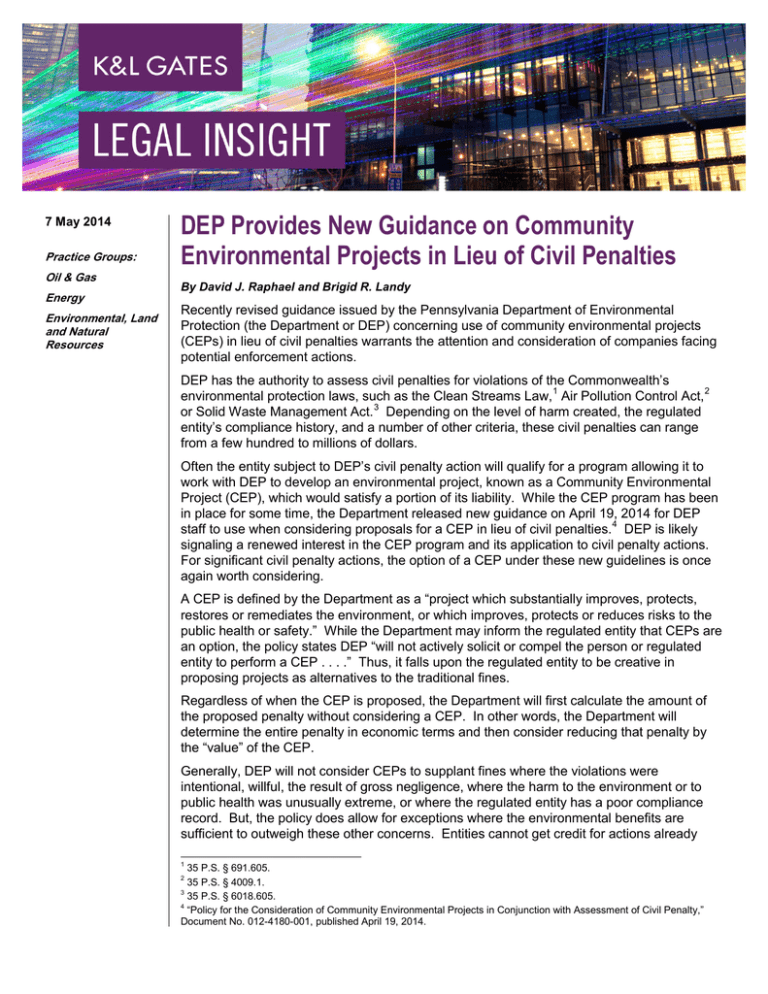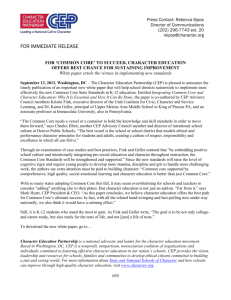
7 May 2014
Practice Groups:
Oil & Gas
Energy
Environmental, Land
and Natural
Resources
DEP Provides New Guidance on Community
Environmental Projects in Lieu of Civil Penalties
By David J. Raphael and Brigid R. Landy
Recently revised guidance issued by the Pennsylvania Department of Environmental
Protection (the Department or DEP) concerning use of community environmental projects
(CEPs) in lieu of civil penalties warrants the attention and consideration of companies facing
potential enforcement actions.
DEP has the authority to assess civil penalties for violations of the Commonwealth’s
environmental protection laws, such as the Clean Streams Law, 1 Air Pollution Control Act,2
or Solid Waste Management Act. 3 Depending on the level of harm created, the regulated
entity’s compliance history, and a number of other criteria, these civil penalties can range
from a few hundred to millions of dollars.
Often the entity subject to DEP’s civil penalty action will qualify for a program allowing it to
work with DEP to develop an environmental project, known as a Community Environmental
Project (CEP), which would satisfy a portion of its liability. While the CEP program has been
in place for some time, the Department released new guidance on April 19, 2014 for DEP
staff to use when considering proposals for a CEP in lieu of civil penalties.4 DEP is likely
signaling a renewed interest in the CEP program and its application to civil penalty actions.
For significant civil penalty actions, the option of a CEP under these new guidelines is once
again worth considering.
A CEP is defined by the Department as a “project which substantially improves, protects,
restores or remediates the environment, or which improves, protects or reduces risks to the
public health or safety.” While the Department may inform the regulated entity that CEPs are
an option, the policy states DEP “will not actively solicit or compel the person or regulated
entity to perform a CEP . . . .” Thus, it falls upon the regulated entity to be creative in
proposing projects as alternatives to the traditional fines.
Regardless of when the CEP is proposed, the Department will first calculate the amount of
the proposed penalty without considering a CEP. In other words, the Department will
determine the entire penalty in economic terms and then consider reducing that penalty by
the “value” of the CEP.
Generally, DEP will not consider CEPs to supplant fines where the violations were
intentional, willful, the result of gross negligence, where the harm to the environment or to
public health was unusually extreme, or where the regulated entity has a poor compliance
record. But, the policy does allow for exceptions where the environmental benefits are
sufficient to outweigh these other concerns. Entities cannot get credit for actions already
1
35 P.S. § 691.605.
35 P.S. § 4009.1.
3
35 P.S. § 6018.605.
4
“Policy for the Consideration of Community Environmental Projects in Conjunction with Assessment of Civil Penalty,”
Document No. 012-4180-001, published April 19, 2014.
2
DEP Provides New Guidance on Community Environmental
Projects in Lieu of Civil Penalties
required by law or as a condition of a permit. While the CEP can supplant fines owed the
Department, it cannot substitute for the obligation to become compliant with the violated
regulations. The proposed project should be conducted in the same “geographic area,
airshed, or watershed where the violation occurred unless the project is intended to have a
regional or statewide benefit.” When possible, the policy also encourages the improvement
be to the environmental medium actually impacted by the harm, be it air, water, or land.
These restrictions imply DEP is not looking to allow offenders to do less through the program
to satisfy their obligation, but is simply redirecting those resources from the state coffers to
tangible environmental improvements in the regions impacted by the violation.
Another theme of the policy is that the benefits of the project must “flow to a community or
the general public rather than the person or regulated entity.” Recognizing such projects
may receive press coverage, the policy states a “CEP may provide the person or regulated
entity with certain ancillary benefits, like media publicity, provided that the project primarily
and substantially benefits the public health or environment.” Also, if the entity actively
publicizes the CEP, “it will state that the project is being undertaken as part of the settlement
of an enforcement action.” If DEP approves the CEP, as part of the agreement the entity
must agree to verify “that no costs associated with the project have been deducted as a
business expense or charitable deduction for the purpose of federal, state, or local taxes.”
The themes mentioned above are also reflected in the list of examples provided by the
Department of acceptable and unacceptable projects:
Acceptable projects include:
1. Remediation of contaminated sites;
2. Restoration of land or water resources not owned by the person or regulated entity;
3. Purchase or donation of land for a local park, state park, or forest land or for some
other public environmental purpose;
4. Programs that advance the Department’s environmental education goals;
5. Assistance to a municipality in the establishment or implementation of a household
hazardous waste or small quantity generator collection program;
6. Assistance to a municipality or non-profit organization for the cleanup of illegal road
side dumping sites of solid wastes; or
7. Assistance to the local emergency response agency for a specific need.
Unacceptable projects include:
1. Projects on property owned by the person or regulated entity;
2. Contributions to an organization that does not focus on environmental, public health,
or community development issues;
3. Performance of projects not directly related to public health and safety or the
environment;
4. Payments to an environmental organization for general purposes as opposed to a
specific project;
5. Payments that are necessary for compliance; and
2
DEP Provides New Guidance on Community Environmental
Projects in Lieu of Civil Penalties
6. General educational or public environmental awareness projects that are not an
integral part of a specific project otherwise acceptable under this guidance.
In developing a CEP, the policy encourages regulated entities to “communicate and
coordinate with members of the public, local non-profits (i.e. watershed groups) or
governmental bodies (i.e. County Conservation Districts) to help identify ‘shovel-ready’
projects for consideration.” While it is up to the regulated entity to quantify the expected
benefits of their proposed CEP, they are permitted to “utilize available resources, such as
consultation with DEP” in assessing the project.
The entity facing violations must submit a detailed description of the proposal to the
appropriate regional office. The proposal must, at a minimum:
• Identify the entity subject to enforcement action;
• Describe the violation or violations;
• Provide a detailed description of the project, including the project location, plan for
implementation and monitoring, cost and resource allocation, and proposed benefits to
public health, safety, and the environment; and
• List any partners and outreach activities.
The Department’s policy directs the program actually taking the enforcement action be the
first to review the proposal for completeness and for the benefits it would provide. Following
this initial review, the Department staff will provide their evaluation and recommendation to
senior staff along with the following:
• The initial proposed penalty without regard to a CEP;
• An evaluation of the proposed CEP; and
• A recommendation regarding the final penalty amount taking into consideration the
CEP, if deemed acceptable.
Finally, once the CEP is deemed acceptable to DEP staff, the “type, scope, and schedule”
must be incorporated into a legally enforceable agreement, such as a Consent Order and
Agreement. The guidance calls for the agreement to set forth requirements for regular
reporting on the progress of the CEP, and contain stipulated penalties for failure to
implement it. The Department may oversee the project, or arrange for third-party oversight.
DEP’s guidance explicitly states that the CEP policy is not intended to alter existing mining or
oil and gas programs that allow operators to reclaim abandoned mine land or plug
abandoned wells. It also does not remove the statutory obligation created under the Air
Pollution Control Act that when a fine assessed under the Act is at least $50,000, 25 percent
of the fine will be returned to the municipality in which the violation occurred.5
The CEP program provides businesses operating in Pennsylvania some flexibility in
satisfying penalties assessed by the Department. It is a creative program that gives industry
the opportunity to utilize expertise and resources already at its disposal to conduct
remediation projects that benefit the Commonwealth of Pennsylvania, while satisfying its
obligations to the Department. DEP’s renewed interest in this program is encouraging,
making the program worthy of industry’s future consideration.
5
35 P.S. § 4009.2(a.1)(1).
3
DEP Provides New Guidance on Community Environmental
Projects in Lieu of Civil Penalties
Authors:
David J. Raphael
dave.raphael@klgates.com
+1.717.231.4574
Brigid R. Landy
brigid.landy@klgates.com
+1.717.231.4573
Anchorage Austin Beijing Berlin Boston Brisbane Brussels Charleston Charlotte Chicago Dallas Doha Dubai Fort Worth Frankfurt
Harrisburg Hong Kong Houston London Los Angeles Melbourne Miami Milan Moscow Newark New York Orange County Palo Alto Paris
Perth Pittsburgh Portland Raleigh Research Triangle Park San Diego San Francisco São Paulo Seattle Seoul Shanghai Singapore Spokane
Sydney Taipei Tokyo Warsaw Washington, D.C. Wilmington
K&L Gates practices out of 48 fully integrated offices located in the United States, Asia, Australia, Europe, the
Middle East and South America and represents leading global corporations, growth and middle-market companies,
capital markets participants and entrepreneurs in every major industry group as well as public sector entities,
educational institutions, philanthropic organizations and individuals. For more information about K&L Gates or its
locations, practices and registrations, visit www.klgates.com.
This publication is for informational purposes and does not contain or convey legal advice. The information herein should not be used or relied upon in
regard to any particular facts or circumstances without first consulting a lawyer.
© 2014 K&L Gates LLP. All Rights Reserved.
4




